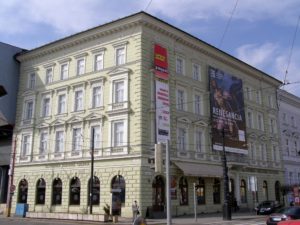
The Slovak National Gallery, at the Esterházy Palace (photo courtesy of Ľubomír Repta)
Over the past month, the Slovak art world has been rocked by disputes between its cultural sector and political leadership.
On August 7th, the cultural minister Martina Šimkovičová dismissed the director of the Slovak National Gallery, Alexandra Kusá. Many see Kusá’s dismissal as part of a purge of Slovakia’s cultural institutions. Other cultural leaders without jobs include the now-former directors of the National Theater, the National Library, and the Bibiana children’s museum in Bratislava. The cultural ministry has given vague or insufficient justifications for the firings if it provided any reason at all. The most recent development in this ongoing saga is that the National Opera’s director, Martin Leginus, has tendered his resignation after parliament failed to oust Šimkovičová after two no-confidence votes. These votes occurred during a special session, so the opposition parties’ efforts must continue when parliament reconvenes in September.
Many expected changes to the cultural sector with Šimkovičová’s appointment in October 2023. While Prime Minister Roberto Fico has been described as a populist leftist, Šimkovičová’s appointment results from his party’s coalition with the conservative Slovak National Party. Šimkovičová’s statements as a member of parliament from 2016 to 2020 and now as cultural minister have been described as nationalist, racist, homophobic, xenophobic, and anti-Semitic. In 2018, Slovakia’s Human Rights Institute named her “homophobe of the year”. Now-former National Theater director Matej Drlička stated that Šimkovičová’s first statement as cultural minister seemed “like a fascist declaration” and that her appointment was when he realized “we were entering a new culture war.” Her conduct as cultural minister has drawn comparisons to Hungarian prime minister Viktor Orbán’s recent crackdowns on media and cultural institutions.
On August 12th and 13th, thousands filled the streets of Bratislava to protest these purges. On the first day of the demonstrations, over three hundred artists and cultural sector employees from across Europe signed an open letter opposing these dismissals. Since then, another one hundred fifty have added their names. The signatories include the directors and curators of Amsterdam’s Stedelijk Museum, Barcelona’s Museum of Contemporary Art, Madrid’s Reina Sofía Museum, Warsaw’s Museum of Modern Art, Zagreb’s Museum of Contemporary Art. The letter states that Kusá’s dismissal “undermined the independence of the cultural field” and “damaged the trust in and reputation of Slovak culture internationally.” The signatories further wrote, “We ask you to reject the direct political control of cultural institutions and defend the right of art and artists to freedom of expression.” On top of the open letter, a petition has circulated to reverse the dismissals, collecting over 180,000 signatures. The National Gallery’s staff has issued a statement in support of its former director, writing that the museum “stands firmly behind Alexandra Kusá, recognizing the immense effort, time, expertise, humanity, innovative vision, and at times, superhuman dedication she has invested in building a national cultural institution that truly understands the real meaning and value of the words ‘national,’ ‘culture,’ and ‘institution.’” Six former Slovak culture ministers have also spoken out against Šimkovičová.
Commentators have expressed confidence in the resistance from Slovakian protestors and cultural figures worldwide. They also seem to think little of the nationalists who support these changes. Drlička has stated, “They haven’t proposed an alternative vision. To say that these people have a grand vision for Slovak culture would be to seriously overestimate them.”
